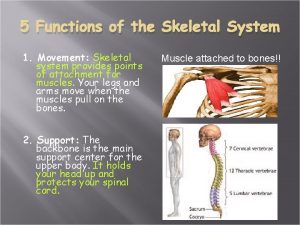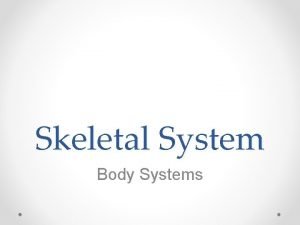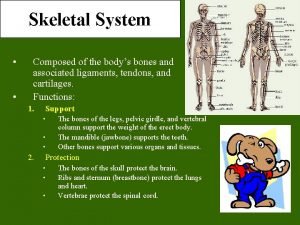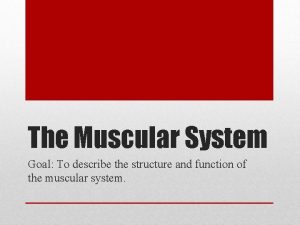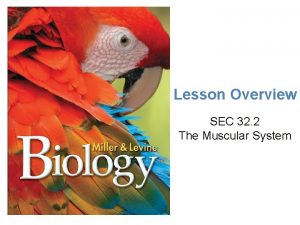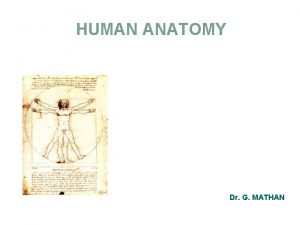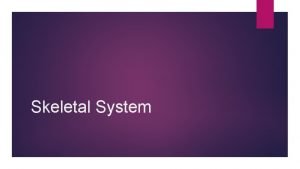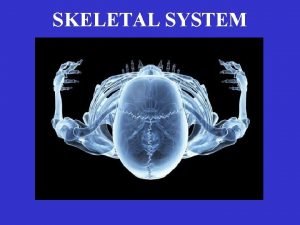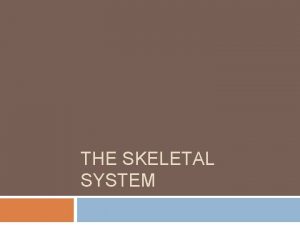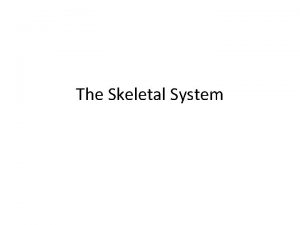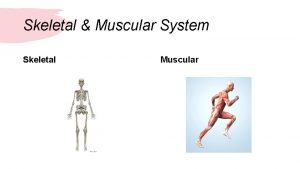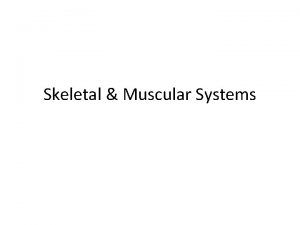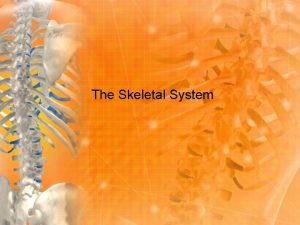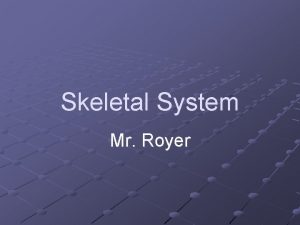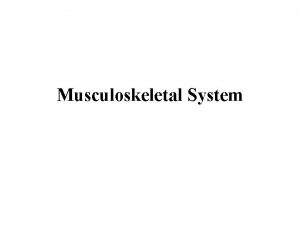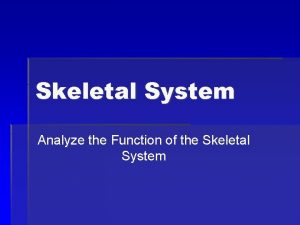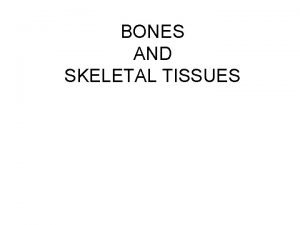Skeletal System Ch 14 Function of the Skeletal






















- Slides: 22

Skeletal System Ch. 14

Function of the Skeletal System • • Function of the Skeletal System – Your skeletal system provides a living structure for your body. – Role of Skeleton • It plays a crucial role in movement by providing a strong, stable and mobile framework on which muscles can act. • It also protects your internal tissues and organs from trauma. • The skull, vertebrae and ribs create a protective cavity for the brain, spinal cord, and the heart and lungs. • Bones store minerals that are important to the health and strength of the skeleton and to various essential processes in your body. – Number of Bones • Your skeletal system consists of 206 bones that can be classified in two main groups. – Classification of Bones • Axial Skeleton: consists of the 80 bones of the skull, spine, ribs, vertebrae, and sternum or breastbone. • Appendicular Skeleton: is composed of the remaining 126 bones of the upper and lower limbs, shoulders and hips.

• Types of Bones – long bones: are hard, dense bones that provide strength, structure, and mobility. A long bone has a shaft and two ends. • Structure of Long Bones – Diaphysis the main column of the bone and is composed of compact bone » Within the diaphysis is a narrow cavity that contains yellow bone marrow stores fat. – Epiphysis the end of a long bone and forms joints with other bones and contains red bone marrow which is where new blood cells are produced. – Short Bones: are almost equal in length and width • Examples include the small bones in the wrists and ankles carpels and tarsals – Flat Bones: are bones whose principal function is either extensive protection or the provision of broad surfaces for muscular attachment • Examples: bones of the skull, the scapula, ribs and sternum – Irregular Bones: serve various purposes in the body, such as protection of nervous tissue. It also provides anchor point for muscle attachment and support. • Examples: vertebra, sacrum, coccyx, temporal, sphenoid, ethmoid, zygomatic, m

• • Cartilage: a strong, flexible connective tissue. It is not as hard and rigid as bone, but it is stiffer and less flexible than muscle. – It can be found at the end of long bones, the nose and the outer ear. – In joints like the knee it acts as a cushion, reducing friction and allowing smooth motion. – An embryos skeleton consists mostly of cartilage that serves as a template from which bones will form. – Early in embryonic development the cartilage hardens • Ossification is the process by which bone is formed, renewed and repaired. Joints: are points at which bones meet. Some joints between bones do not moves such as in the skull as other have limited movement like the vertebrae. – Flexible Joints are classified as one of the following types • Ball and socket: are formed when the rounded head of one bone fits into the rounded cavity of an adjoining bone, such as the hip or shoulder joint. These have the widest range of motion. • Hinge joints: allow a joint to bed and straighten promoting rotation such as the elbow, knee, ankle and fingers. • Pivot joints: allow limited rotation or turning such as the head/neck

• Gliding joints: also known as a plane joint or planar joint, is a common type of synovial joint formed between bones that meet at flat or nearly flat articular surfaces. They allow the bones to glide past one another in any direction along the plane of the joint – up and down, left and right, and diagonally. An example would be the space between the carpal bones of the wrist; between the carpals and the metacarpals of the palm; between the tarsal bones of the ankle; and between the tarsals and the metatarsals of the foot – Ligament: is a band of fibrous, slightly elastic connective tissue that attaches bone to bone. • They help to stabilize the movements of bones at a joint. – Tendon is a fibrous cord that attaches muscle to the bone. – Movement is produced because muscles are attached to bones by tendons and ligaments.

Movement and Anchorage • • • Anatomical terms of movement are used to describe the actions of muscles on the skeleton. Muscles contract to produce movement at joints – where two or more bones meet. As in anatomical terms of location, the terms used assume that the body starts in the anatomical position. Most movements have an opposite or counter movement. – Anatomical Position: The position with the body erect with the arms at the sides and the palms forward. – The anatomical position is of importance in anatomy because it is the position of reference for anatomical terminology. Anatomical Position Anterior (Frontal position) Posterior (back position)

Movement and Anchorage • – Abduction: refers to a motion that pulls a structure or part away from the midline of the body or taking away from. • For example, raising the arms up, such as when tightrope-walking, is an example of abduction at the shoulder. When the legs are wide at the hip, such as when doing a star jump or doing a split, the legs are abducted at the hip. – Adduction: refers to a motion that pulls a structure or part toward the midline of the body, or adding back to the body. • For example, dropping the arms to the sides, or bringing the knees together, are examples of adduction Video of Abduction and Adduction https: //youtu. be/Xm. BMQc. T 1_KU

Movement and Anchorage • • • Flexion and extension describe movements that affect the angle between two parts of the body. Flexion describes a bending movement that decreases the angle between a segment and its proximal segment. – For example, bending the elbow, or clenching a hand into a fist, are examples of flexion. When sitting down, the knees are flexed. – When a joint can move forward and backward, such as the neck and trunk, flexion refers to movement in the forward direction. Flexion of the shoulder or hip refers to movement of the arm or leg forward. Extension is the opposite of flexion, describing a straightening movement that increases the angle between body parts. – When a joint can move forward and backward, such as the neck and trunk, extension refers to movement in the posterior (backwards) direction. – For example, when standing up, the knees are extended. Extension of the hip or shoulder moves the arm or leg backward. When the chin is against the

Movement and Anchorage – Circumduction: Moving a part so that its end follows a circular path • Example: moving the finger in a circular motion without moving the hand. – Rotation: Moving a part around an axis (twisting the head from side to side). – Medial rotation involves movement toward the midline, whereas lateral rotation involves movement in the opposite direction. – Dorsiflexion: Bending the foot at the ankle toward the shin (bending the foot upward). – Plantar flexion: Bending the foot at the ankle toward the sole (bending the foot downward). Dorsiflexion and Plantar flexion Circumduction and Rotation

Movement and Anchorage • • • Pronation and Supination of the writs/forearms. Pronation and supination of the wrists is a unique movement that does not occur else where in the body. – Pronation of the wrist moves the palm of the hand so that it is facing posteriorly (your forearms are pronated when typing on a keyboard – Supination of the wrist moves the palm of the hand so that it is facing anteriorly (your hands are supinated when holding a bowl of soup). Pronation and Supination also refers to movement of the ankle when walking or running – Pronation of the ankle inward movement of the foot as it rolls to distribute the force of impact of the ground as you run. The foot "rolls" inward about fifteen percent, comes in complete contact with the ground, and can support your body weight without any problem. Pronation is critical to proper shock absorption, and it helps you push off evenly from the front of the foot. • Overpronation of the ankle is when the foot rolls inward more than the ideal fifteen percent. This means the foot and ankle have problems stabilizing the body, and shock isn't absorbed as efficiently. This can cause calluses, bunions, runner's knee, plantar fasciitis, and Achilles

Pronation and Supination is the insufficient inward roll of the foot after landing. The inward movement of the foot occurs at less than fifteen percent (i. e. , there is less rolling in than for those with normal or flat feet). Consequently, the impact of the ground is concentrated on the outside of the foot and the shock is not distributed as efficiently. This places extra stress on the foot, which can lead to iliotibial band syndrome, Achilles tendinitis, and plantar fasciitis. Underpronating will cause the outer edge of running shoes to wear sooner. Of the foot of the wrist

Muscle Contractions • When we think of a muscle contracting normally, we tend to think of the muscle shortening as it generates force. While it's true that this is a way of muscle contracting, there are many different ways that a muscle can generate force, • Muscle Contraction is defined as the movement of muscle fibers in response to force or load. • There are 3 different types of Muscle contractions • Isotonic (meaning same tension) • Isometric (meaning same distance or not moving) • Isokinetic (meaning same speed) • Isotonic Contractions • Isotonic contractions are those which cause the muscle to change length as it contracts and causes movement of a body part. • There are two types of Isotonic contraction: Concentric and Eccentric • Concentric contractions: Contractions in which it causes the muscle to shorten as it contracts. • When a muscle is activated and required to lift a load which is less than the maximum tension it can generate, the muscle begins to shorten.

Muscle Contraction • Isotonic Contraction continued • Concentric Contraction: An example is bending the elbow from straight to fully flexed, causing a concentric contraction of the Biceps Brachii muscle. • Concentric contractions are the most common type of muscle contraction and occur frequently in daily and sporting activities. • Eccentric contractions are the opposite of concentric and occur when the muscle lengthens as it contracts. • During normal activity, muscles are often active while they are lengthening. Classic examples of this are walking, when the quadriceps (knee extensors) are active just after heel strike while the knee flexes, or setting an object down gently (the arm flexors must be active to control the fall of the object). • As the load on the muscle increases, it finally reaches a point where the external force on the muscle is greater than the force that the muscle can generate. This forces the muscle to lengthen due to the high external load. • Main feature to note regarding eccentric contractions is the ability to set down a much heavier object is easier than lifting an heavier object • Example kicking a football, the Quad muscle contracts concentrically

Muscle Contraction • Isometric Contractions • Isometric contractions occur when there is no change in the length of the contracting muscle. • There is no change in length of the muscle, and no movement at the joints but muscle fibers do contract. • This occurs when carrying an object in front of you as the weight of the object is pulling your arms down but your muscles are contracting to hold the object at the same level. • Another example is when you grip something , such as a tennis racket. There is no movement in the joints of the hand, but the muscles are contracting to provide a force sufficient enough to keep a steady hold on the racket. • The amount of force a muscle is able to produce during an isometric contraction depends on the length of the muscle at the point of contraction. Each muscle has an optimum length at which the maximum isometric force can be produced

Muscle Contractions • Isokinetic contractions are similar to isotonic in that the muscle changes length during the contraction, where they differ is that Isokinetic contractions produce movements of a constant speed. • An isokinetic muscle contraction is one in which the muscle contracts and shortens at constant rate of speed. This type of muscle contraction usually requires special, expensive training equipment that increases the load as it senses that the muscle contraction is speeding up. • To measure this a special piece of equipment known as an Isokinetic Dynamometer is required. Examples of using isokinetic contractions in day-to-day and sporting activities are rare. The best is breast stroke in swimming, where the water provides a constant, even resistance to the movement of adduction • The benefit of this type of resistance training is that the muscle gains strength evenly all through the entire range of movement and it is one of the fastest ways to increase muscle strength.

Biomechanics • • Basic Biomechanics There are certain biomechanical principles which govern human movement. Knowledge of these principles can be helpful when learning new skills, teaching new skills, analyzing movement or improving efficiency in movement. • Force and Resistance – Force — The pushing or pulling effect that one body can exert on another. An object at rest can be made to move when another object exerts a force on it. The contraction of a muscle acting on a joint is an example of this. Muscle contraction is also known as internal force. – Resistance — Resistance is a force that acts on or can be applied to the body. Holding the weight of a body part against gravity, carrying an object, or pulling a bar down on a lat machine, are all examples of resistance. We use muscular force to overcome applied resistance.

Levers • Levers – A lever is a rigid bar or mass which rotates around a fixed point called the axis of rotation or fulcrum. – Rotation is the result of force applied to the lever. If a force acting on the lever is great enough to offset the weight (or resistance), then the lever will move. – In the example of a lever system (Figure 5. 1) there is a balance. To move this lever there must be enough force at one end (Forceful Freddy) to offset the resistance of the weight at the other end (Ricky Resistance). The further away the resistance is from the fulcrum, the more force required to move the lever. – In the human body the bone represents the lever, the joint represents the fulcrum (axis of rotation), the weight of the body parts and any additional

Manipulating Force, Resistance and Velocity • Velocity – Velocity is the speed of an object in motion. Once an object is in motion, it will continue in motion unless acted on by another force. This relates to the concept of momentum. • Manipulating Force, Resistance and Velocity – Exercises can be modified (made easier or more difficult) by manipulating the resistance, the lever length, or the speed of the movement. – 1. Resistance: the amount of load used (added to the body part) Figure 5. 3 • greater load = more resistance = more difficulty • less load = less resistance = less difficulty – 2. Length of the Lever Arm: the distance between the joint (fulcrum) and the resistance (body weight in this case) Figure 5. 3 • The longer the lever the more difficult the exercise • The shorter the lever the easier the exercise

Manipulating Force, Resistance and Velocity – 3. Force/Velocity: the relationship between the force exerted and the speed of movement Graph 5. 1 • A faster movement requires less muscular force to overcome the resistance (e. g. quickly curling a 20 lb. dumbbell) • A slower movement requires more muscular force to overcome the resistance (e. g. slowly curling a 20 lb. dumbbell).

Gravity, Stability and Base of Support • Gravity is the constant force which pulls objects towards the earth. Gravity sometimes works to assist our movements while at other times the body must generate force to overcome its effects. – Movements which are gravity assisted (any downward movement): • - lowering an object to the floor • - sitting down in a chair • - the down phase of a squat – Movements which are against gravity (any upward movement): • - going up stairs • - getting up out of a chair • - the up phase of a squat – Movements which go against gravity generally require more force and are therefore more difficult

Stability • • • Stability – The word stable is defined as "firmly fixed or established, not easily moved or changed or unbalanced. ” – When we exercise our bodies are constantly being affected by external forces (e. g. gravity, momentum etc. ) and we must exert effort to avoid being displaced. Stability can be enhanced internally by the contraction of muscles to hold the body still and externally by manipulating the base of support and/or the position of the body. Base of Support – The base of the support relates to the surface supporting the body and the points of contact with that surface. In standing, therefore, the base of support means the position of the feet on the surface of the ground. Center of Gravity – This is a body’s center of mass, or balance point. in It is usually located in the torso area, but can also be outside of the body depending on its position space.

Manipulation the Base of Support • Manipulating the Base of Support and Center of Gravity – Stability can be increased or decreased by manipulating the base of support and centre of gravity. – 1. Base of Support • Stability is increased with the number of points of contact (standing on two feet versus standing on one foot) • Stability is increased with the optimal distance between the points of contact (standing with the feel slightly apart versus feet together or extremely wide apart) • Stability is increased by positioning the body on a stable surface – 2. Centre of Gravity • Stability is increased by moving the centre of gravity closer to the ground. • Stability is increased by balancing the centre of gravity directly over the base of support.
 5 main function of skeletal system
5 main function of skeletal system Whats the main function of the skeletal system
Whats the main function of the skeletal system Crash course skeletal system
Crash course skeletal system 5 function of skeletal system
5 function of skeletal system Trunk muscles
Trunk muscles Function of skeletal muscle
Function of skeletal muscle Function of muscles
Function of muscles Function of skeletal muscle
Function of skeletal muscle Forearm muscle
Forearm muscle Function of skeletal muscle
Function of skeletal muscle Hát kết hợp bộ gõ cơ thể
Hát kết hợp bộ gõ cơ thể Ng-html
Ng-html Bổ thể
Bổ thể Tỉ lệ cơ thể trẻ em
Tỉ lệ cơ thể trẻ em Chó sói
Chó sói Thang điểm glasgow
Thang điểm glasgow Hát lên người ơi
Hát lên người ơi Các môn thể thao bắt đầu bằng tiếng đua
Các môn thể thao bắt đầu bằng tiếng đua Thế nào là hệ số cao nhất
Thế nào là hệ số cao nhất Các châu lục và đại dương trên thế giới
Các châu lục và đại dương trên thế giới Công thức tính độ biến thiên đông lượng
Công thức tính độ biến thiên đông lượng Trời xanh đây là của chúng ta thể thơ
Trời xanh đây là của chúng ta thể thơ Mật thư tọa độ 5x5
Mật thư tọa độ 5x5
